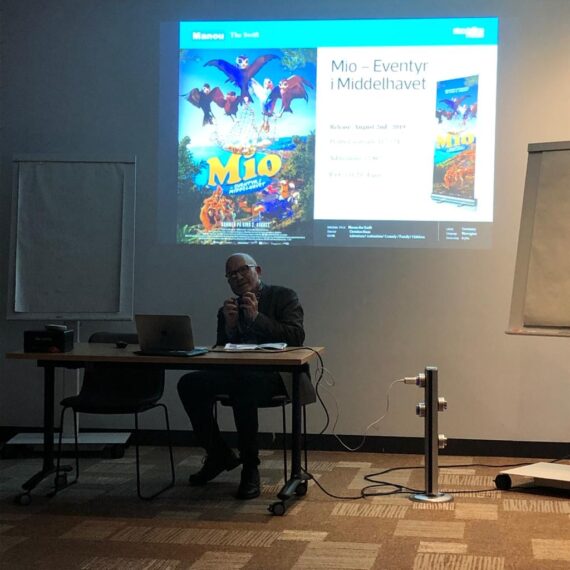Over the past few years several independent distributors started to invest more in animation films for family and kids, in order to vary their line-up and grow their audience. Until five-six years ago the big studios specialised in animation were releasing fewer films per year, following a regular calendar and many independents distributors found there was a niche market for independent animation. Things started to change when the number of animation films released per year started to drastically grow, coming both from big studios and smaller indie productions. The competition for screens and for the young audience’s attention inevitably raised, and some distributors feel that today in several European territories the market for independent animation is close to saturation. How can distributors help animation films to circulate and find new audiences?
Within the framework of the Cartoon Movie event held in Bordeaux (3-5 March), Europa Distribution organised a workshop for its members focused on the theatrical release of animation films, inviting distributors to discuss about their experiences, highlighting the best practices as well as unsuccess stories where valuable lessons could be shared and learnt.
Laure Caillol (Haut et Court, France) kicked off the session by discussing the release of Pachamama, a film by Juan Antin, coproduced by France, Luxembourg and Canada, by the same team behind successful films such as Kirikou and Ernest and Célestine with whom Haut et Court had a long and established relationship. Despite the difficult period of the release in France, marked by strikes and street protests, the film premieres (around 200) were a success. Caillol pointed out that arthouse animation films always need a longer time to reach their audience, compared to live films, and it’s therefore all the more important to receive support to grant a film a longer tail. This title for example gained the French young audience special support that encouraged exhibitor to take it and keep it in theatres. If the film was selected for the « école et cinéma » programme, this would grant a film an even longer life with school screenings, potentially triple the number of overall admissions.
Joao Paulo Abreu (Films4You, Portugal) and Emil Simeonov (Pro Films, Bulgaria) compared their strategy and results on the release of Marnie’s World (Germany, Belgium) in their respective territories. In both countries cinemas are controlled by big chains who represent 60% (Portugal) to 85% (Bulgaria) of the market, and in both territories due to an excessive number of other films targeting young audiences released in the same period, these large groups did not take the film, leaving only a few screenings available for the releases that did not therefore match the distributors’ expectations.
Offering the possibility to compare the release of two different type of animation on the same territory, Joao Froes (Outsider Films, Portugal) shared some details of the campaigns created by Outsider Films for Cats and Peachtopia (China) and for Mary and the Witch’s Flower (Japan). Competition was once again key to determine the success of the films. In fact, despite releasing Mary and the Witch’s Flower in a period traditionally more appealing for young audiences, and with a similar P&A budget to Cats and Peachtopia, Mary and the Witch’s Flower did not manage to reach the same results, facing a stronger competition from the popular Russian animation The Big Trip.
Manou the Swift (Germany) had a complicated production history that led to postponing its release date in most of the territories where the film had been acquired but thanks to the attribution of the MEDIA Selective support, distributors could count on some extra support for the release. Frank Johnsen (Storytelling) explained that in Norway over the past three years the situation with animation films has evolved quite rapidly. “When we started releasing animation 3,5 years ago, we could find more easily the space for our films as the big studios had fixed times for their releases. Now that many other distributors started to release animation finding a date has become a real struggle”. In order to face the fierce competition Johnsen advised to pay special attention to the local titles – extremely important for the film’s positioning in the local market – and to dubbing. With Manou the Swift for example Storytelling decided to engage young Norwegian influencers instead of regular actors in order to boost the promotion of the films.
Sabine Hofmann (Polyfilm, Austria) offered an overview of her market explaining that, due to its limited size, Austrian distributors are always forced to get sublicensing from German distributors. Cinema audience is in fact used to watch films only in German and dubbing costs would be prohibiting for local distributors. Polyfilm has a 30 years long love-history with animation, since the company released Aardman’s shorts Creature Comforts in theatres. Wallace & Gromit was on and off in theatres for no less than six years (1989-1995) making over 100.000 admissions. Always buying films they love and believe in, over the years the Polyfilm team also learnt to keep certain releases small in order to recoup their investments. With Bunuel in the Labyrinth of Turtles, a arthouse animation film based on a graphic about film director Luis Buñuel making the 1933 film Land Without Bread, Polyfilm will adopt a strategy of event screenings, aiming at adults and students interested in History, Art and Cinema, thanks also to the collaboration with film and art schools. The film will be released mid-March.
Throughout the workshop some specificities of the challenges of releasing animation clearly emerged: competition for screens and for young audience’s attention, need for funding and support to produce extra materials dedicated to kids, importance of long releases and second windows and additional value of programmes that can give the films a second life with schools.
Europa Distribution will continue next year its partnership with Cartoon to help distributors discovering new gems from the animation world and to share with other companies ideas and tools on how bring great films closer to the audience.
